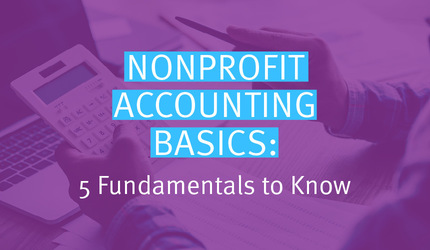
Now that your new nonprofit is up and running, developing a solid foundation for financial management should be a top priority. The ins and outs of nonprofit accounting may seem overwhelming at first, but effectively recording and reporting your organization’s finances is essential to fund your mission.
To help you get started, this guide will cover the basics of nonprofit accounting, including:
- The Difference Between For-Profit and Nonprofit Accounting
- Budgeting
- Fiscal Policies and Procedures
- Financial Statements
- Tax Returns
If you still have questions as you begin applying these strategies at your organization, consider reaching out to a nonprofit accountant. These professionals have the expertise necessary to set up your accounting system and work with you on nearly any aspect of financial management. For now, let’s dive in with an overview of how nonprofit accounting is different from that of for-profit organizations.
1. The Difference Between For-Profit and Nonprofit Accounting
Most for-profit organizations’ main goal in accounting is to earn the largest possible profit. However, nonprofits like yours can’t turn a profit by definition—all of the funding you bring in has to be reinvested into your organization.
The core of nonprofit accounting is accountability. The way you manage and report financial information holds your organization accountable to the government, the Generally Accepted Accounting Principles (GAAP), and your supporters. Your accounting system, therefore, should be set up in a way that promotes transparency about how your nonprofit is using its resources to further its mission.
2. Budgeting
Your nonprofit’s annual budget is a key financial planning document that guides your organization’s spending and fundraising efforts. It details all of the costs you expect to incur and the funds you predict you’ll bring in throughout the year.
Most nonprofits break down the revenue side of their budget by source. These categories may include:
- Individual donations of all sizes and varieties.
- Corporate contributions such as matching gifts and sponsorships.
- Earned income from merchandise sales and membership dues.
- Grants provided by the government and foundations.
On the expense side, spending is usually organized based on whether it directly furthers your mission (program expenses) or it’s necessary for your nonprofit’s fundraising and administrative activities (overhead expenses). For example, an animal shelter would categorize the costs of providing food and veterinary care to rescue pets under their program expenses and the money they spend on creating marketing materials for the organization under their overhead expenses.
In the first few years of your organization’s existence, your overhead expenses may be relatively high since you’re just getting started with fundraising and fine-tuning your operations. But over time, you should look for ways to reduce those costs and put the majority of your funding toward your programs.
3. Fiscal Policies and Procedures
Along with your budget, your fiscal policies and procedures provide guidance for how your team should handle your organization’s funds day to day. Jitasa’s nonprofit financial management guide recommends creating the following fiscal policies:
- Gift acceptance. This policy details the types of donations (both monetary and in-kind) that your organization can and can’t accept, as well as the procedure for recording each type of contribution.
- Conflict of interest. When a leader or board member at your organization has an opportunity for personal or business gain that could conflict with their duty to act in your nonprofit’s best interest, this policy outlines the steps for disclosing and addressing the conflict to protect your organization and its finances.
- Expense reimbursement. If staff members or volunteers ever spend their personal money on behalf of your nonprofit, this policy lays out the process for reimbursing them.
- Staff compensation. This policy provides guidelines for how your employees are compensated for their work at your organization. As NXUnite’s guide to nonprofit human resources explains, the policy should include information about indirect compensation such as health insurance and paid time off in addition to direct compensation like salaries and bonuses.
Compile all of these policies in a handbook to serve as a reference for your employees. Make sure the document can easily be updated as your nonprofit grows—you may eventually need more involved procedures for handling different types of funding.
4. Financial Statements
As you fundraise and spend in accordance with your budget and fiscal policies, your nonprofit will end up collecting a large amount of financial data. However, this information is only useful if you summarize and organize it in a way that allows you to glean applicable insights into your organization’s financial situation.
This is where financial statements come in. In accordance with GAAP standards, your nonprofit should compile the following four reports:
- Statement of activities. The nonprofit equivalent of the for-profit income statement, this report organizes your revenue, expenses, and net assets for a given year. You can compare this statement to the predictions in that year’s budget and then make more accurate projections for the following year.
- Statement of financial position. Also called a balance sheet, this statement breaks down your nonprofit’s assets and liabilities to provide a snapshot of your organization’s financial health. It’s useful in growth planning and if your nonprofit undergoes a financial audit.
- Statement of cash flows. This statement shows how cash moves in and out of your organization through operating, investing, and financing activities. Because it’s usually pulled monthly, it helps keep your organization’s spending and fundraising on track.
- Statement of functional expenses. The one financial statement unique to nonprofits, this report details your program, fundraising, and administrative expenses to help you reduce overhead and put more funding toward your mission.
Many nonprofits publish their financial statements as appendices to their annual reports, increasing transparency with supporters. Plus, these documents are helpful to reference as your organization files its annual tax returns.
5. Filing online tax forms
Although your nonprofit has been granted tax-exempt status by the IRS, you still have to file a tax return each year. This document, known as Form 990, proves to the federal government that your organization is following the guidelines they’ve set out for nonprofits.
There are four versions of Form 990, and which one your organization has to fill out depends on your annual gross receipts:
- Newer, smaller nonprofits like yours can often file Form 990-N (also known as the e-postcard), so long as your gross receipts total less than $50,000.
- If your organization’s gross receipts total more than $50,000 but less than $200,000, the shortest form you can file is Form 990-EZ, which is four pages long.
- Eventually, if your nonprofit grows to the point where your annual gross receipts total more than $200,000, you’ll need to file the full 12-page Form 990.
- All private foundations have to file the 13-page Form 990-PF, regardless of their annual gross receipts.
No matter which version your nonprofit completes, the Form 990 filing deadline is the 15th day of the fifth month after your fiscal year ends. For most organizations, whose fiscal year follows the calendar year, that due date is May 15. Late submissions can incur fines, and failing to file for three consecutive years risks your organization’s tax-exempt status, so plan ahead to get your form in on time!
The Bottom Line
Although nonprofit accounting requires you to manage many moving parts, it becomes less complicated when you understand the fundamentals. Stay focused on your goal of organizational accountability as you put together your budget, fiscal policies, financial statements, and tax returns. Also, don’t hesitate to reach out for expert accounting help if any questions or challenges arise.
About the Author
Jon Osterburg has spent the last nine years helping more than 100 nonprofits around the world with their finances as a leader at Jitasa, an accounting firm that offers bookkeeping and accounting services to not for profit organizations.






